HLTENN004: Assessment on Implementing, Monitoring Nursing Care Plans
VerifiedAdded on 2020/01/28
|25
|5099
|649
Homework Assignment
AI Summary
This document presents a comprehensive nursing care plan assessment for the HLTENN004 course, focusing on implementing, monitoring, and evaluating nursing care plans. The assessment covers a wide range of topics, including factors influencing comfort, rest, and sleep, and the importance of activities of daily living (ADLs). It explores the use of aids to assist clients with ADLs, addressing scenarios like hemiplegia, osteoarthritis, Parkinson's disease, and recent falls. The assessment includes a detailed case study of a 67-year-old patient with a history of stroke, diabetes, and other conditions, examining hygiene, grooming, pressure injury prevention, and falls prevention. The document further addresses nursing care needs related to mobility, elimination, nutrition, and personal hygiene. It also covers urinary incontinence, including treatment strategies and aids for toileting, and concludes with the initial steps of resuscitation. The assessment provides practical insights into various aspects of nursing care and patient management.

Attention Students:
This is an editable word document.
This word copy of assessment is for student to work offline. Please DO
NOT upload this document in Student Hub. You can copy and paste
answers from this word document to your online assessment.
Assessments
Course
Unit : HLTENN004 Implement, monitor and evaluate nursing
care plans
Assessment
type : Theory Assessment
Displaying 1 to 16 out of 16 total.
1. Comfort, rest and sleep are important factors in an individual’s life.
Answer the following questions. (50 words each answer)
1.1 Identify four (4) factors that promote comfort, rest and sleep.
This is an editable word document.
This word copy of assessment is for student to work offline. Please DO
NOT upload this document in Student Hub. You can copy and paste
answers from this word document to your online assessment.
Assessments
Course
Unit : HLTENN004 Implement, monitor and evaluate nursing
care plans
Assessment
type : Theory Assessment
Displaying 1 to 16 out of 16 total.
1. Comfort, rest and sleep are important factors in an individual’s life.
Answer the following questions. (50 words each answer)
1.1 Identify four (4) factors that promote comfort, rest and sleep.
Paraphrase This Document
Need a fresh take? Get an instant paraphrase of this document with our AI Paraphraser
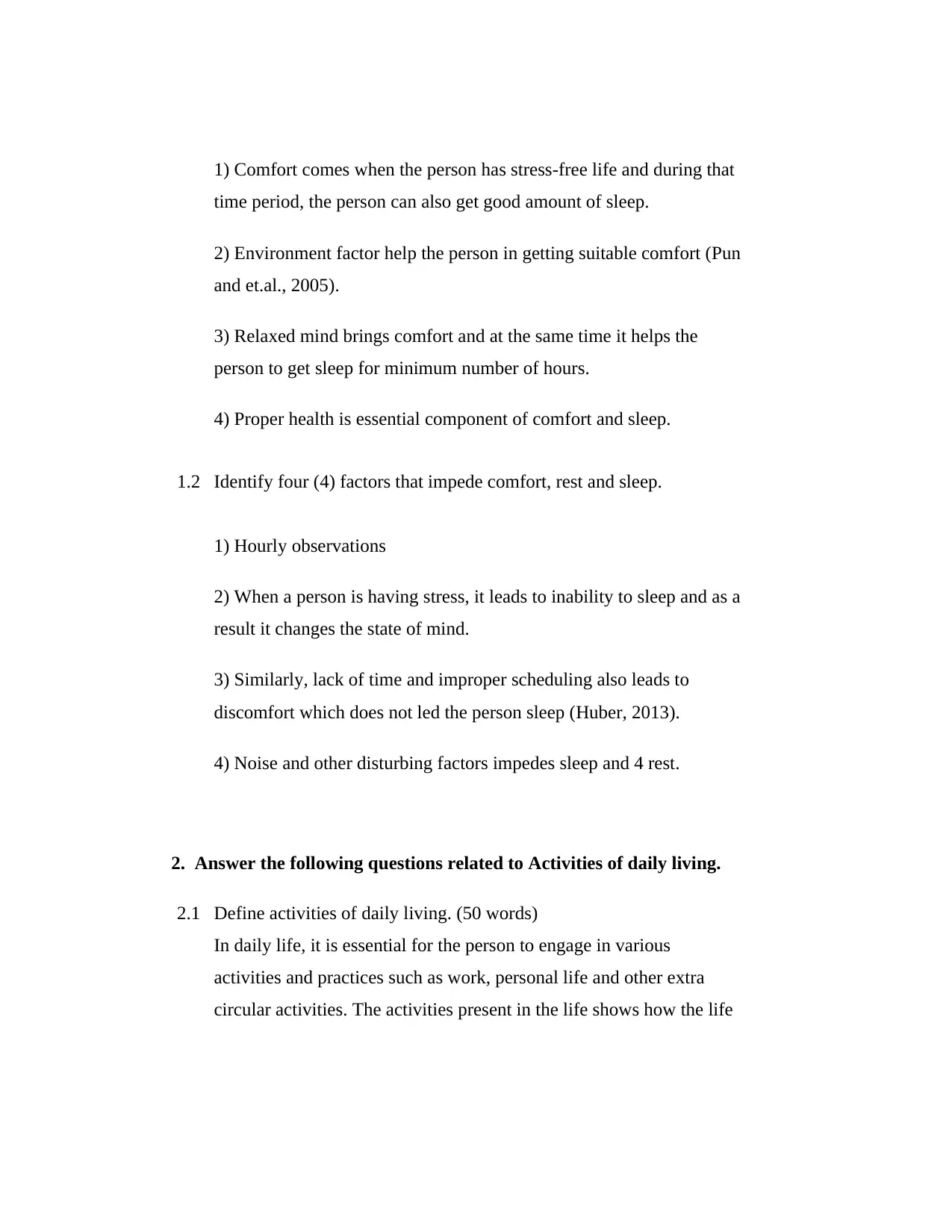
1) Comfort comes when the person has stress-free life and during that
time period, the person can also get good amount of sleep.
2) Environment factor help the person in getting suitable comfort (Pun
and et.al., 2005).
3) Relaxed mind brings comfort and at the same time it helps the
person to get sleep for minimum number of hours.
4) Proper health is essential component of comfort and sleep.
1.2 Identify four (4) factors that impede comfort, rest and sleep.
1) Hourly observations
2) When a person is having stress, it leads to inability to sleep and as a
result it changes the state of mind.
3) Similarly, lack of time and improper scheduling also leads to
discomfort which does not led the person sleep (Huber, 2013).
4) Noise and other disturbing factors impedes sleep and 4 rest.
2. Answer the following questions related to Activities of daily living.
2.1 Define activities of daily living. (50 words)
In daily life, it is essential for the person to engage in various
activities and practices such as work, personal life and other extra
circular activities. The activities present in the life shows how the life
time period, the person can also get good amount of sleep.
2) Environment factor help the person in getting suitable comfort (Pun
and et.al., 2005).
3) Relaxed mind brings comfort and at the same time it helps the
person to get sleep for minimum number of hours.
4) Proper health is essential component of comfort and sleep.
1.2 Identify four (4) factors that impede comfort, rest and sleep.
1) Hourly observations
2) When a person is having stress, it leads to inability to sleep and as a
result it changes the state of mind.
3) Similarly, lack of time and improper scheduling also leads to
discomfort which does not led the person sleep (Huber, 2013).
4) Noise and other disturbing factors impedes sleep and 4 rest.
2. Answer the following questions related to Activities of daily living.
2.1 Define activities of daily living. (50 words)
In daily life, it is essential for the person to engage in various
activities and practices such as work, personal life and other extra
circular activities. The activities present in the life shows how the life
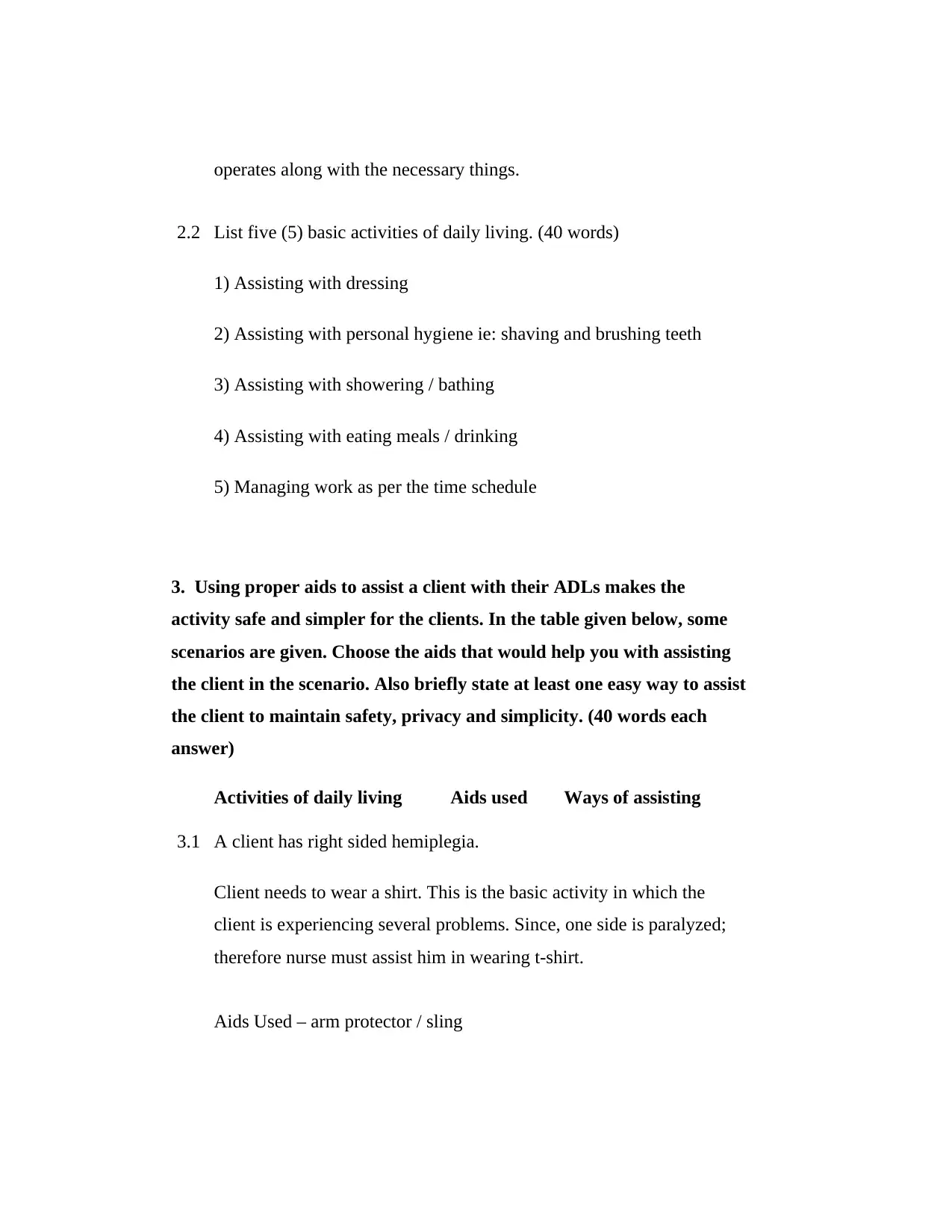
operates along with the necessary things.
2.2 List five (5) basic activities of daily living. (40 words)
1) Assisting with dressing
2) Assisting with personal hygiene ie: shaving and brushing teeth
3) Assisting with showering / bathing
4) Assisting with eating meals / drinking
5) Managing work as per the time schedule
3. Using proper aids to assist a client with their ADLs makes the
activity safe and simpler for the clients. In the table given below, some
scenarios are given. Choose the aids that would help you with assisting
the client in the scenario. Also briefly state at least one easy way to assist
the client to maintain safety, privacy and simplicity. (40 words each
answer)
Activities of daily living Aids used Ways of assisting
3.1 A client has right sided hemiplegia.
Client needs to wear a shirt. This is the basic activity in which the
client is experiencing several problems. Since, one side is paralyzed;
therefore nurse must assist him in wearing t-shirt.
Aids Used – arm protector / sling
2.2 List five (5) basic activities of daily living. (40 words)
1) Assisting with dressing
2) Assisting with personal hygiene ie: shaving and brushing teeth
3) Assisting with showering / bathing
4) Assisting with eating meals / drinking
5) Managing work as per the time schedule
3. Using proper aids to assist a client with their ADLs makes the
activity safe and simpler for the clients. In the table given below, some
scenarios are given. Choose the aids that would help you with assisting
the client in the scenario. Also briefly state at least one easy way to assist
the client to maintain safety, privacy and simplicity. (40 words each
answer)
Activities of daily living Aids used Ways of assisting
3.1 A client has right sided hemiplegia.
Client needs to wear a shirt. This is the basic activity in which the
client is experiencing several problems. Since, one side is paralyzed;
therefore nurse must assist him in wearing t-shirt.
Aids Used – arm protector / sling
⊘ This is a preview!⊘
Do you want full access?
Subscribe today to unlock all pages.

Trusted by 1+ million students worldwide

Ways of assisting – by physically assisting the client
3.2 A client has difficulty feeding himself due to chronic osteoarthritis in
wrist and knuckles.
Aids used – Assistance is required from the nurse in terms of
changing the ways to move. Nursing intervention can also be adopted
at the same time so that the medical conditions can be improved.
Variety of equipment can be arranged for the client.
Ways of assisting – cutting up the food
3.3 Client has Parkinsons disease moderately affecting his mobility.
Client needs to get up from his bed and stand
Aids used – Proper attention should be given towards the use of
equipment that aids in managing movement. Movable chair can also
be used at the time of managing movement of the client.
Ways of assisting – through helping the client in moving from one
place to another (Ouslander, Bonner, Herndon and Shutes, 2014).
3.4 Client is old and had a recent fall. He finds it hard to walk by himself.
In this case, nurse should adopt any sort of fall prevention strategy so
that the client can be protected from further falls. Assistance is
required to be given to the patient so that easy movement can be
facilitated. Thus, wheel chair can be provided to the patient.
4. A 67 year old lady with history of stroke and left sided hemiplegia is
admitted in your unit. She also has a history of type 2 Diabetes mellitus
and acute renal failure (now resolved). She is having a second degree
3.2 A client has difficulty feeding himself due to chronic osteoarthritis in
wrist and knuckles.
Aids used – Assistance is required from the nurse in terms of
changing the ways to move. Nursing intervention can also be adopted
at the same time so that the medical conditions can be improved.
Variety of equipment can be arranged for the client.
Ways of assisting – cutting up the food
3.3 Client has Parkinsons disease moderately affecting his mobility.
Client needs to get up from his bed and stand
Aids used – Proper attention should be given towards the use of
equipment that aids in managing movement. Movable chair can also
be used at the time of managing movement of the client.
Ways of assisting – through helping the client in moving from one
place to another (Ouslander, Bonner, Herndon and Shutes, 2014).
3.4 Client is old and had a recent fall. He finds it hard to walk by himself.
In this case, nurse should adopt any sort of fall prevention strategy so
that the client can be protected from further falls. Assistance is
required to be given to the patient so that easy movement can be
facilitated. Thus, wheel chair can be provided to the patient.
4. A 67 year old lady with history of stroke and left sided hemiplegia is
admitted in your unit. She also has a history of type 2 Diabetes mellitus
and acute renal failure (now resolved). She is having a second degree
Paraphrase This Document
Need a fresh take? Get an instant paraphrase of this document with our AI Paraphraser

pressure sore in the sacral area. She is incontinent with urine and
continent with faeces. She has upper dentures and lower row of own
teeth. She uses bilateral hearing aids and glasses. She is on regular pain
relief tablets and still has occasional pain in her left leg and gets
headaches very often which is usually relieved by Paracetamol.
Current reason for admission is lethargy and acopia at home. Family
found the client confused at times and not attending to hygiene and
grooming by self as she used to do before. You are assigned to provide
comprehensive care to her. Answer the following questions.
4.1 Mention four (4) purposes of hygiene and grooming.
1) To reduce infection
2) To promote wellbeing
3) To remain clean and tidy
4) To get engaged in physical fitness
4.2 Enlist four (4) contributing factors of pressure injury.
1) Pressure injury is caused in the lady because there is a pressure
against the skin that limits blood flow to the skin and surrounded
tissue.
2) Limited mobility is yet another reason that lead to pressure sore and
continent with faeces. She has upper dentures and lower row of own
teeth. She uses bilateral hearing aids and glasses. She is on regular pain
relief tablets and still has occasional pain in her left leg and gets
headaches very often which is usually relieved by Paracetamol.
Current reason for admission is lethargy and acopia at home. Family
found the client confused at times and not attending to hygiene and
grooming by self as she used to do before. You are assigned to provide
comprehensive care to her. Answer the following questions.
4.1 Mention four (4) purposes of hygiene and grooming.
1) To reduce infection
2) To promote wellbeing
3) To remain clean and tidy
4) To get engaged in physical fitness
4.2 Enlist four (4) contributing factors of pressure injury.
1) Pressure injury is caused in the lady because there is a pressure
against the skin that limits blood flow to the skin and surrounded
tissue.
2) Limited mobility is yet another reason that lead to pressure sore and
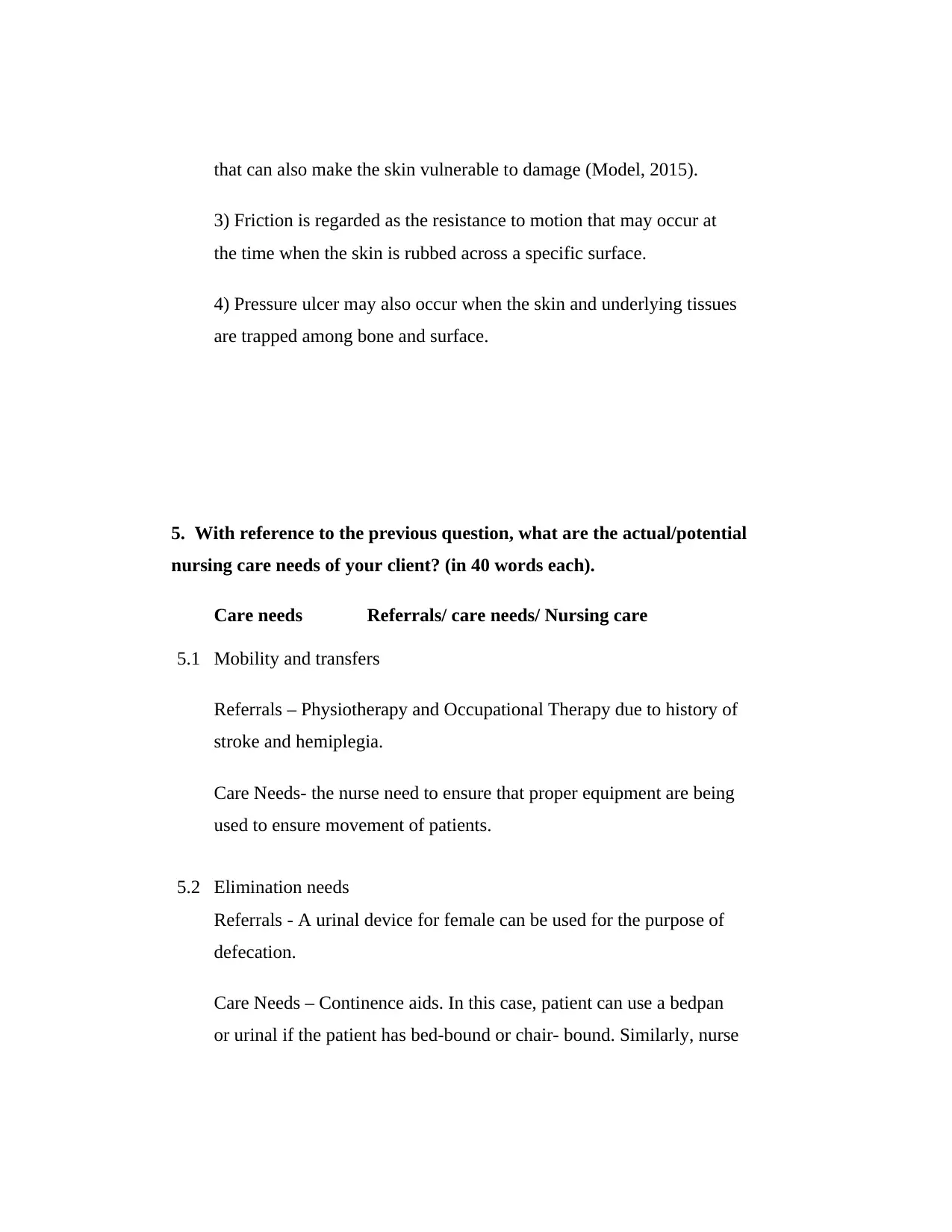
that can also make the skin vulnerable to damage (Model, 2015).
3) Friction is regarded as the resistance to motion that may occur at
the time when the skin is rubbed across a specific surface.
4) Pressure ulcer may also occur when the skin and underlying tissues
are trapped among bone and surface.
5. With reference to the previous question, what are the actual/potential
nursing care needs of your client? (in 40 words each).
Care needs Referrals/ care needs/ Nursing care
5.1 Mobility and transfers
Referrals – Physiotherapy and Occupational Therapy due to history of
stroke and hemiplegia.
Care Needs- the nurse need to ensure that proper equipment are being
used to ensure movement of patients.
5.2 Elimination needs
Referrals - A urinal device for female can be used for the purpose of
defecation.
Care Needs – Continence aids. In this case, patient can use a bedpan
or urinal if the patient has bed-bound or chair- bound. Similarly, nurse
3) Friction is regarded as the resistance to motion that may occur at
the time when the skin is rubbed across a specific surface.
4) Pressure ulcer may also occur when the skin and underlying tissues
are trapped among bone and surface.
5. With reference to the previous question, what are the actual/potential
nursing care needs of your client? (in 40 words each).
Care needs Referrals/ care needs/ Nursing care
5.1 Mobility and transfers
Referrals – Physiotherapy and Occupational Therapy due to history of
stroke and hemiplegia.
Care Needs- the nurse need to ensure that proper equipment are being
used to ensure movement of patients.
5.2 Elimination needs
Referrals - A urinal device for female can be used for the purpose of
defecation.
Care Needs – Continence aids. In this case, patient can use a bedpan
or urinal if the patient has bed-bound or chair- bound. Similarly, nurse
⊘ This is a preview!⊘
Do you want full access?
Subscribe today to unlock all pages.

Trusted by 1+ million students worldwide
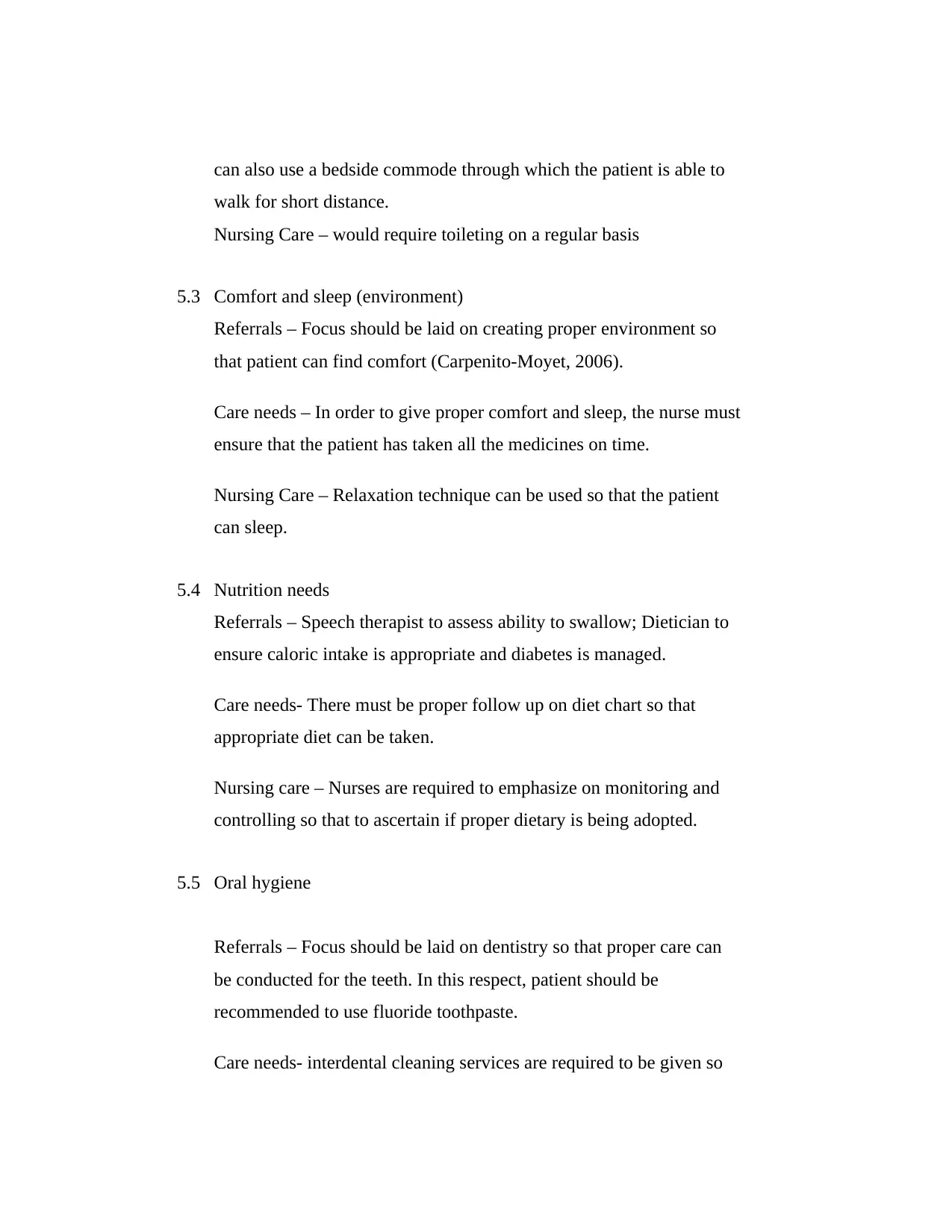
can also use a bedside commode through which the patient is able to
walk for short distance.
Nursing Care – would require toileting on a regular basis
5.3 Comfort and sleep (environment)
Referrals – Focus should be laid on creating proper environment so
that patient can find comfort (Carpenito-Moyet, 2006).
Care needs – In order to give proper comfort and sleep, the nurse must
ensure that the patient has taken all the medicines on time.
Nursing Care – Relaxation technique can be used so that the patient
can sleep.
5.4 Nutrition needs
Referrals – Speech therapist to assess ability to swallow; Dietician to
ensure caloric intake is appropriate and diabetes is managed.
Care needs- There must be proper follow up on diet chart so that
appropriate diet can be taken.
Nursing care – Nurses are required to emphasize on monitoring and
controlling so that to ascertain if proper dietary is being adopted.
5.5 Oral hygiene
Referrals – Focus should be laid on dentistry so that proper care can
be conducted for the teeth. In this respect, patient should be
recommended to use fluoride toothpaste.
Care needs- interdental cleaning services are required to be given so
walk for short distance.
Nursing Care – would require toileting on a regular basis
5.3 Comfort and sleep (environment)
Referrals – Focus should be laid on creating proper environment so
that patient can find comfort (Carpenito-Moyet, 2006).
Care needs – In order to give proper comfort and sleep, the nurse must
ensure that the patient has taken all the medicines on time.
Nursing Care – Relaxation technique can be used so that the patient
can sleep.
5.4 Nutrition needs
Referrals – Speech therapist to assess ability to swallow; Dietician to
ensure caloric intake is appropriate and diabetes is managed.
Care needs- There must be proper follow up on diet chart so that
appropriate diet can be taken.
Nursing care – Nurses are required to emphasize on monitoring and
controlling so that to ascertain if proper dietary is being adopted.
5.5 Oral hygiene
Referrals – Focus should be laid on dentistry so that proper care can
be conducted for the teeth. In this respect, patient should be
recommended to use fluoride toothpaste.
Care needs- interdental cleaning services are required to be given so
Paraphrase This Document
Need a fresh take? Get an instant paraphrase of this document with our AI Paraphraser
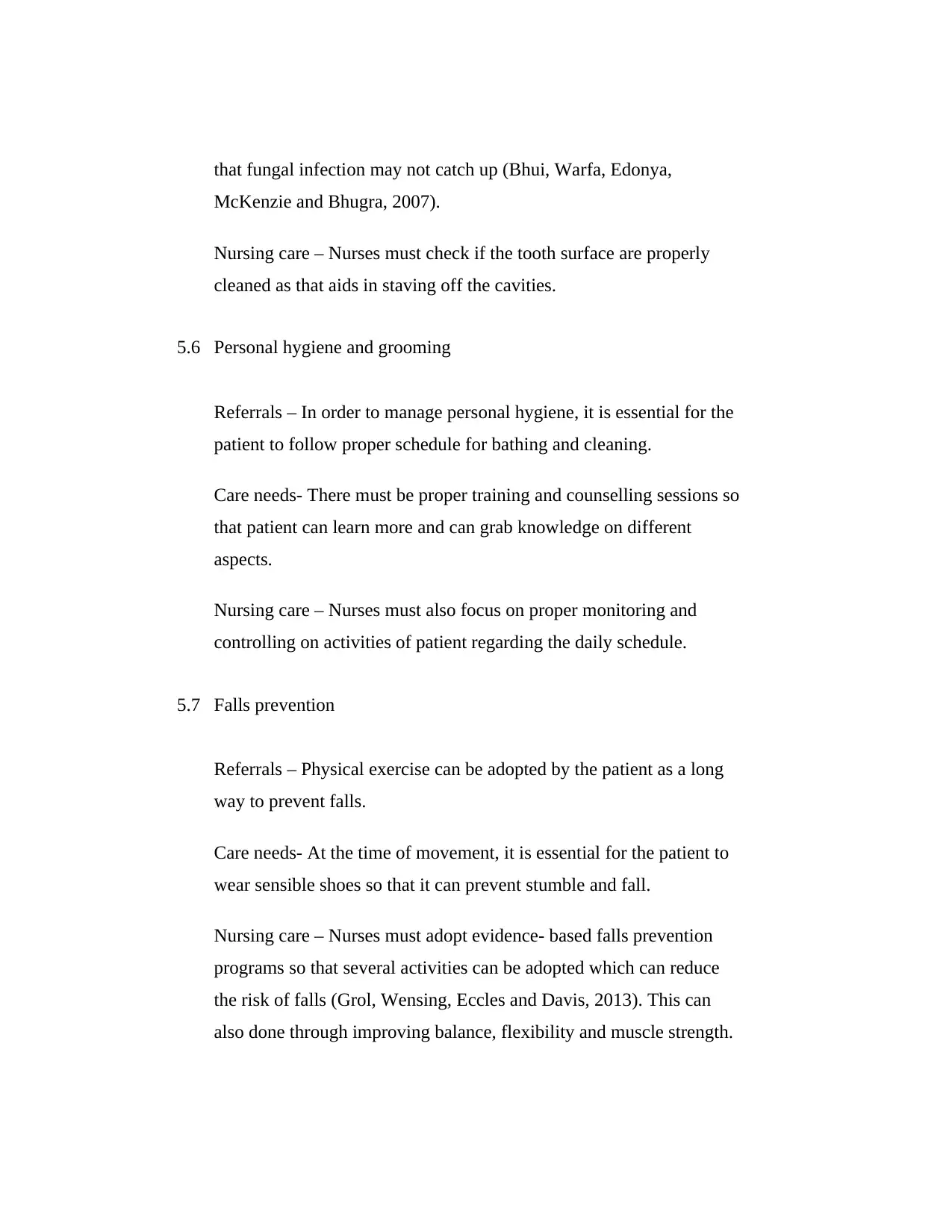
that fungal infection may not catch up (Bhui, Warfa, Edonya,
McKenzie and Bhugra, 2007).
Nursing care – Nurses must check if the tooth surface are properly
cleaned as that aids in staving off the cavities.
5.6 Personal hygiene and grooming
Referrals – In order to manage personal hygiene, it is essential for the
patient to follow proper schedule for bathing and cleaning.
Care needs- There must be proper training and counselling sessions so
that patient can learn more and can grab knowledge on different
aspects.
Nursing care – Nurses must also focus on proper monitoring and
controlling on activities of patient regarding the daily schedule.
5.7 Falls prevention
Referrals – Physical exercise can be adopted by the patient as a long
way to prevent falls.
Care needs- At the time of movement, it is essential for the patient to
wear sensible shoes so that it can prevent stumble and fall.
Nursing care – Nurses must adopt evidence- based falls prevention
programs so that several activities can be adopted which can reduce
the risk of falls (Grol, Wensing, Eccles and Davis, 2013). This can
also done through improving balance, flexibility and muscle strength.
McKenzie and Bhugra, 2007).
Nursing care – Nurses must check if the tooth surface are properly
cleaned as that aids in staving off the cavities.
5.6 Personal hygiene and grooming
Referrals – In order to manage personal hygiene, it is essential for the
patient to follow proper schedule for bathing and cleaning.
Care needs- There must be proper training and counselling sessions so
that patient can learn more and can grab knowledge on different
aspects.
Nursing care – Nurses must also focus on proper monitoring and
controlling on activities of patient regarding the daily schedule.
5.7 Falls prevention
Referrals – Physical exercise can be adopted by the patient as a long
way to prevent falls.
Care needs- At the time of movement, it is essential for the patient to
wear sensible shoes so that it can prevent stumble and fall.
Nursing care – Nurses must adopt evidence- based falls prevention
programs so that several activities can be adopted which can reduce
the risk of falls (Grol, Wensing, Eccles and Davis, 2013). This can
also done through improving balance, flexibility and muscle strength.
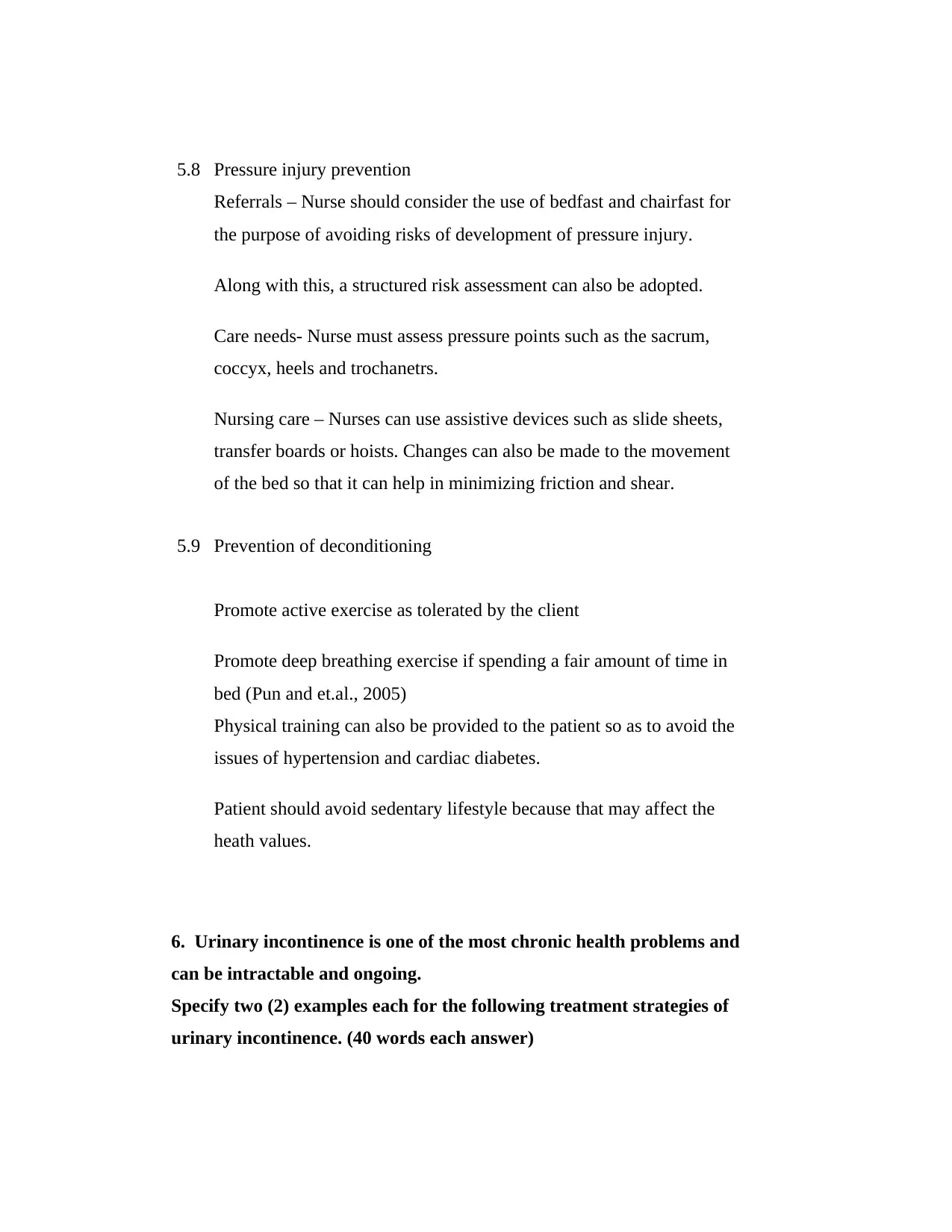
5.8 Pressure injury prevention
Referrals – Nurse should consider the use of bedfast and chairfast for
the purpose of avoiding risks of development of pressure injury.
Along with this, a structured risk assessment can also be adopted.
Care needs- Nurse must assess pressure points such as the sacrum,
coccyx, heels and trochanetrs.
Nursing care – Nurses can use assistive devices such as slide sheets,
transfer boards or hoists. Changes can also be made to the movement
of the bed so that it can help in minimizing friction and shear.
5.9 Prevention of deconditioning
Promote active exercise as tolerated by the client
Promote deep breathing exercise if spending a fair amount of time in
bed (Pun and et.al., 2005)
Physical training can also be provided to the patient so as to avoid the
issues of hypertension and cardiac diabetes.
Patient should avoid sedentary lifestyle because that may affect the
heath values.
6. Urinary incontinence is one of the most chronic health problems and
can be intractable and ongoing.
Specify two (2) examples each for the following treatment strategies of
urinary incontinence. (40 words each answer)
Referrals – Nurse should consider the use of bedfast and chairfast for
the purpose of avoiding risks of development of pressure injury.
Along with this, a structured risk assessment can also be adopted.
Care needs- Nurse must assess pressure points such as the sacrum,
coccyx, heels and trochanetrs.
Nursing care – Nurses can use assistive devices such as slide sheets,
transfer boards or hoists. Changes can also be made to the movement
of the bed so that it can help in minimizing friction and shear.
5.9 Prevention of deconditioning
Promote active exercise as tolerated by the client
Promote deep breathing exercise if spending a fair amount of time in
bed (Pun and et.al., 2005)
Physical training can also be provided to the patient so as to avoid the
issues of hypertension and cardiac diabetes.
Patient should avoid sedentary lifestyle because that may affect the
heath values.
6. Urinary incontinence is one of the most chronic health problems and
can be intractable and ongoing.
Specify two (2) examples each for the following treatment strategies of
urinary incontinence. (40 words each answer)
⊘ This is a preview!⊘
Do you want full access?
Subscribe today to unlock all pages.

Trusted by 1+ million students worldwide

Treatment strategy Examples(2)
6.1 Behavioural technique
1) Pelvic floor exercises
2) Biofeedback
6.2 Pharmacologic technique
1) Oestrogen
2) Collagen
6.3 Mechanical treatment
1) Pessaries
2) Urethral insert (in/out catheter)
7. Urinary incontinence is one of the most chronic health problems and
6.1 Behavioural technique
1) Pelvic floor exercises
2) Biofeedback
6.2 Pharmacologic technique
1) Oestrogen
2) Collagen
6.3 Mechanical treatment
1) Pessaries
2) Urethral insert (in/out catheter)
7. Urinary incontinence is one of the most chronic health problems and
Paraphrase This Document
Need a fresh take? Get an instant paraphrase of this document with our AI Paraphraser

can be intractable and ongoing. (50 words each answer)
7.1 68 year old Janice complains of urge incontinence. Janice is a slow
walker and uses a 4 wheeled walker for ambulation. Janice had a fall
while trying to get to the toilet to urinate. What aids could be used to
assist Janice with toileting? How can we make Janices environment
safe to avoid falls?
- Place commode beside the bed (Bryant‐Lukosius, DiCenso, Browne
and Pinelli, 2004)
- referral to Incontinence advisor
Further, she could also be provided urinal devices so that her health
conditions can be resolved as early as possible.
Nurse can also be appointed at the same time so that she can assist her
in managing toiletry.
7.2 82 year old Bob is under palliative care. Bob is bed bound. Bob has
functional incontinence of urine and faeces. This makes him highly
susceptible to pressure injuries, macerations and skin breakdown.
Also, it would be very uncomfortable for client. What aids could be
used to assist Bob with toileting comfortably?
- Use of urodome and continence pads
- Regular turning
- The nearby area should be kept dry all the time so nurses are
required to ensure that proper hygienic aspects can be
undertaken.
7.1 68 year old Janice complains of urge incontinence. Janice is a slow
walker and uses a 4 wheeled walker for ambulation. Janice had a fall
while trying to get to the toilet to urinate. What aids could be used to
assist Janice with toileting? How can we make Janices environment
safe to avoid falls?
- Place commode beside the bed (Bryant‐Lukosius, DiCenso, Browne
and Pinelli, 2004)
- referral to Incontinence advisor
Further, she could also be provided urinal devices so that her health
conditions can be resolved as early as possible.
Nurse can also be appointed at the same time so that she can assist her
in managing toiletry.
7.2 82 year old Bob is under palliative care. Bob is bed bound. Bob has
functional incontinence of urine and faeces. This makes him highly
susceptible to pressure injuries, macerations and skin breakdown.
Also, it would be very uncomfortable for client. What aids could be
used to assist Bob with toileting comfortably?
- Use of urodome and continence pads
- Regular turning
- The nearby area should be kept dry all the time so nurses are
required to ensure that proper hygienic aspects can be
undertaken.
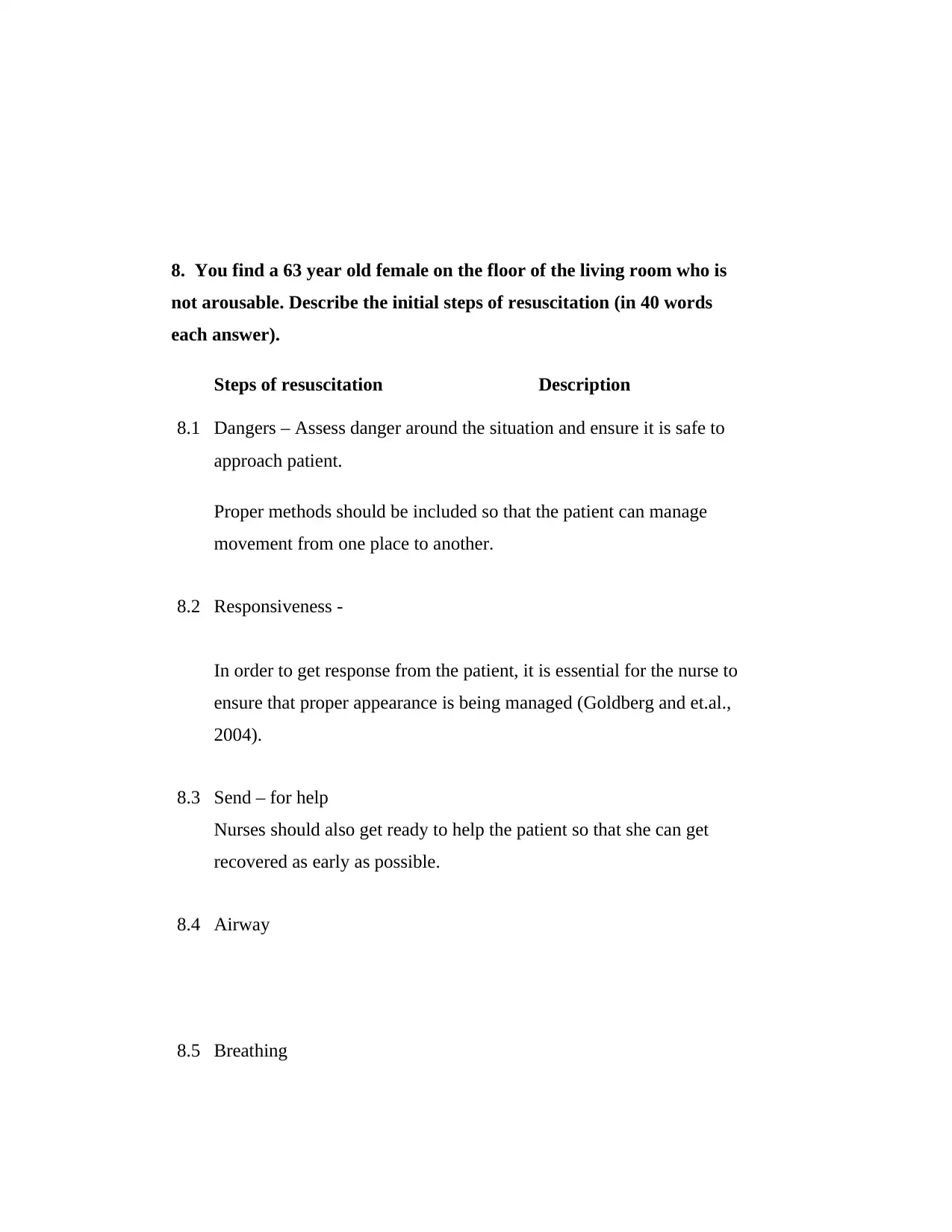
8. You find a 63 year old female on the floor of the living room who is
not arousable. Describe the initial steps of resuscitation (in 40 words
each answer).
Steps of resuscitation Description
8.1 Dangers – Assess danger around the situation and ensure it is safe to
approach patient.
Proper methods should be included so that the patient can manage
movement from one place to another.
8.2 Responsiveness -
In order to get response from the patient, it is essential for the nurse to
ensure that proper appearance is being managed (Goldberg and et.al.,
2004).
8.3 Send – for help
Nurses should also get ready to help the patient so that she can get
recovered as early as possible.
8.4 Airway
8.5 Breathing
not arousable. Describe the initial steps of resuscitation (in 40 words
each answer).
Steps of resuscitation Description
8.1 Dangers – Assess danger around the situation and ensure it is safe to
approach patient.
Proper methods should be included so that the patient can manage
movement from one place to another.
8.2 Responsiveness -
In order to get response from the patient, it is essential for the nurse to
ensure that proper appearance is being managed (Goldberg and et.al.,
2004).
8.3 Send – for help
Nurses should also get ready to help the patient so that she can get
recovered as early as possible.
8.4 Airway
8.5 Breathing
⊘ This is a preview!⊘
Do you want full access?
Subscribe today to unlock all pages.

Trusted by 1+ million students worldwide
1 out of 25
Related Documents
Your All-in-One AI-Powered Toolkit for Academic Success.
+13062052269
info@desklib.com
Available 24*7 on WhatsApp / Email
![[object Object]](/_next/static/media/star-bottom.7253800d.svg)
Unlock your academic potential
Copyright © 2020–2025 A2Z Services. All Rights Reserved. Developed and managed by ZUCOL.





